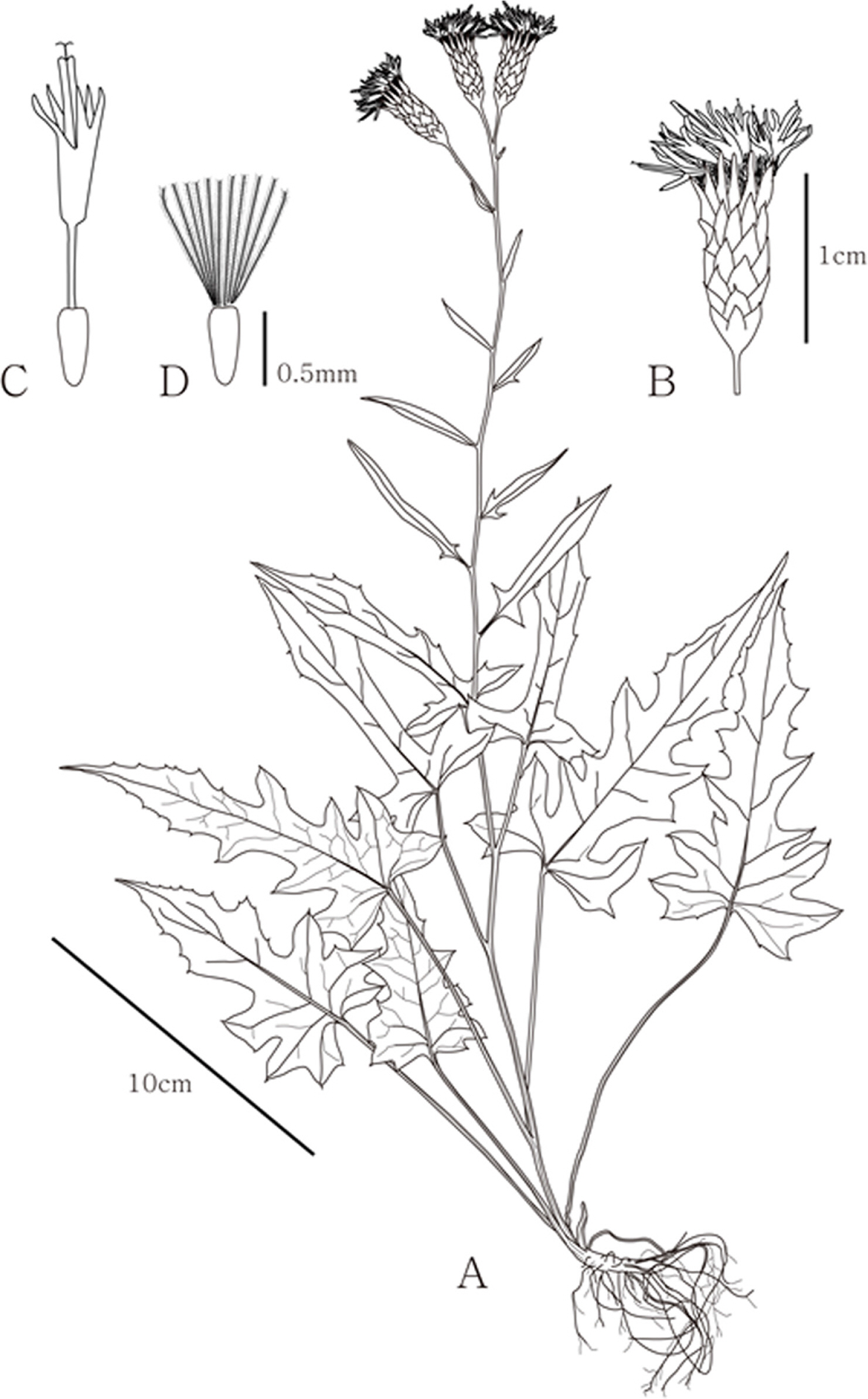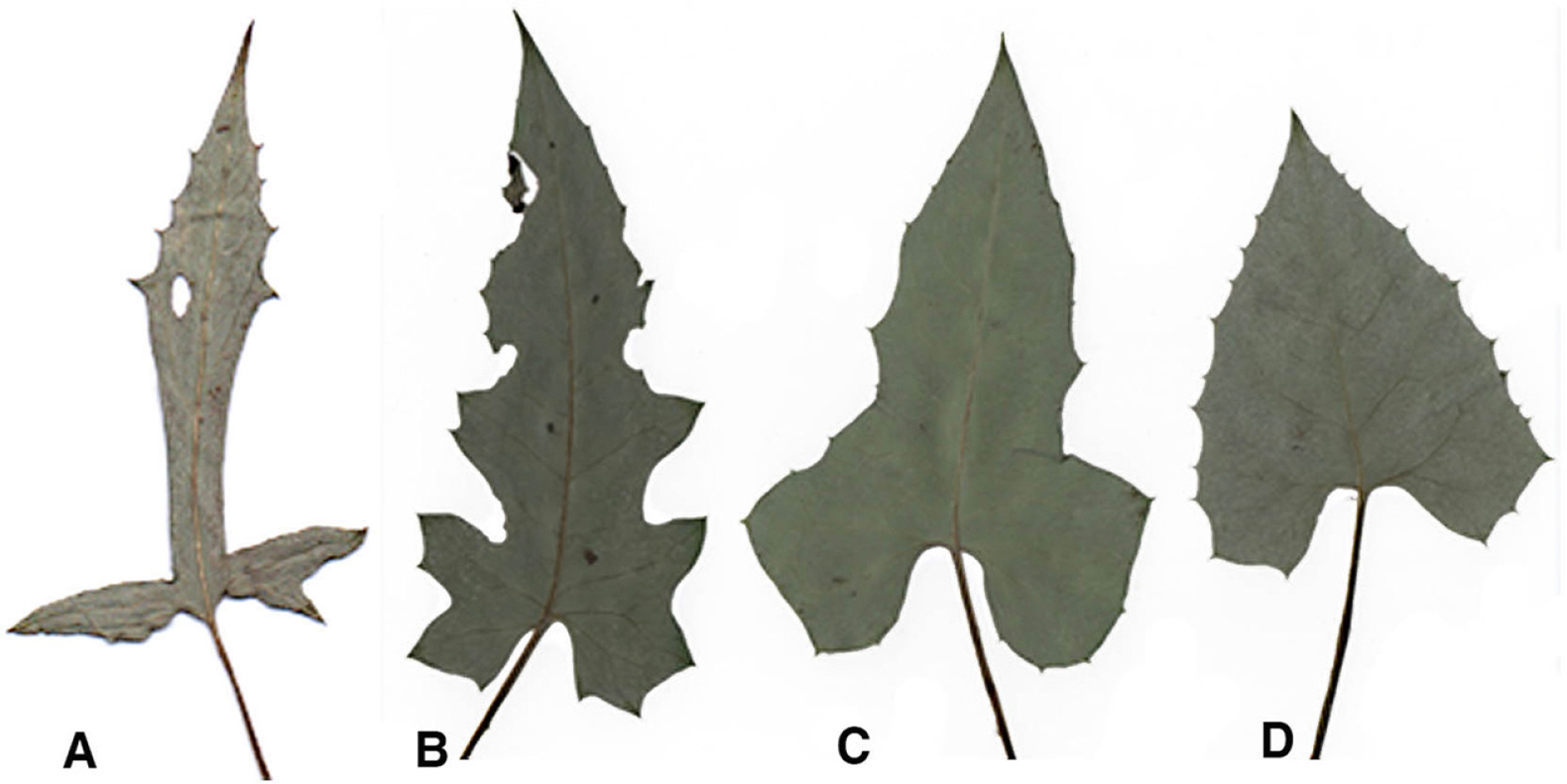적 요경상남도 남해도에서 발견된 취나물속의 신종을 남해분취(Saussurea namhaedoana)로 기재했다. 이 종 은 우리나라 특산으로 근생엽이 화기까지 숙존하며, 잎은 극형, 전형또는 드물게 심장형으로 잎 가장자리는 중열 또는 큰 거치가 발달하고, 아랫면에 조락하는 회백색 거미줄 털이 밀생하며, 총포는 통형으로 회백색 거미줄 털로 덮여 있다. 자생 취나물속 식물 중에 잎 아랫면에 회백색 또는 흰색 털이 밀생하는 종으로는 은 분취(S. gracilis), 함백취(S. albifolia), 서울분취(S. seoulensis), 백운취(S. insularis)가 있으나, 극형, 전형의 잎 은 남해분취만의 특징이다.
Abstract
Saussurea namhaedoana, a new endemic species narrowly restricted to Namhaedo Island of Korea, is reported in this study. It can be distinguished from other congeneric species of Saussurea in Korea by having persistent radical leaves until flowering, hastate or sagittate leaves with mucronate toothed to undulate-lobulate margins, grayish cobwebby hairs on abaxial leaf surfaces when young, and tubular involucre with grayish cobwebby hairs. Morphologically, S. namhaedoana is closely related to other species in Korea, such as S. gracilis Maxim., S. insularis Kitam., S. seoulensis Nakai and S. albifolia M. J. Nam and H. T. Im, sharing grayish or white hairs on the abaxial leaf surfaces. It, however, can be distinguished from its close relatives by having a distinct leaf shape, i.e., sagittate or hastate leaves. The phylogenetic relationship relative to congeners in East Asia is yet to be determined.
INTRODUCTION
Saussurea DC. (Compositae) is composed of approximately 380 species (Lipschitz, 1979), occurring mainly at high altitudes in Asia. While some species, such as S. maximowiczii Herd., S. grandifolia Maxim., and S. odontolepis Maxim., occur widely throughout northeastern Asia, others are very narrowly restricted to limited regions as a consequence of local geographical adaptations. Of 33 species of Saussurea in Korea (Im, 2017; Sun et al., 2021a, 2021b), three endemics and two unrecorded species have been reported over the last three decades. In contrast, the number of Saussurea species in Japan has increased significantly from 25 species (Kitamura et al., 1982) to 63 species (Kadota, 2017) during almost the same period, and Chinese Saussurea had increased from 264 species (Chen and Shih, 1999) to 289 species (Shih, 2011). Saussurea is one of the highly diversified and adaptable groups in Asteraceae, and further discovery of new Saussurea species in Korea is highly anticipated. Recently, in the course of studying Korean endemic plants, we discovered a new species of Saussurea endemic to Korea in the Namhaedo Island.
TAXONOMIC TREATMENT
Saussurea namhaedoana J. M. Chung & H. T. Im, sp. nov. (Figs. 1, 2).––TYPE: KOREA. Gyeongsangnam-do, Namhae-gun, Gohyeon-myeon, Mt. Mangunsan, Hwabang-sa (temple), elev. 240 m, 17 Sep 2021, H. T. Im & S. Y. Park 211582 (holotype: CNU!).
Korean name: Nam-hae-bun-chui (남해분취).
Herbs, Perennial. Rhizomes obliquely prostrating with many fibrous rootlets. Stems 2–2.5 mm in diam. at base, 25–55 cm long, erect, loosely branched, striate on upper part, grayish white hairs when young. Leaves alternate, adaxial surface deep or pale green, glabrous, abaxial surface grayish cobwebby while young; radical leaves in rosettes, persistent till anthesis, petiole 5–12 cm long; blade, sagittate, hastate, rarely cordate, 5–12 × 2–4.2 cm, apex acuminate, base hastate, auriculate, cordate, margins undulate-lobulate, mucronate-toothed; median and upper cauline leaves gradually smaller upward, petiolate or sessile, blade narrow lanceolate to linear. Heads several in loosely corymbose synflorescence, 0.9–1.1 cm in diam.; peduncles 0.4–4.5 cm long; involucre tubular, 8–12 × 4–6 mm, gray-white cobwebby; phyllaries 5–7 seriate, light green on middle and upper part; outer phyllaries oval-lanceolate, apex mucronate or acute; middle phyllaries sage green, oblong or oblong-lanceolate; inner phyllaries linear. Florets pale purple; corolla tubular 8.5–10 mm long, wide part and narrow part same length, limb 5-lobed. Cypselae cylindrical, 4–5 mm long; pappus bristles 2-seriate; outer series 0.4–1.8 mm long; inner series grayish white, 8.5–9.5 mm long.
Flowering: September to October.
Distribution: Mountainous region of Namhaedo Island, Gyongsangnam-do, Korea.
Specimens examined: KOREA. Gyeongsangnam-do: Namhae-gun, Gohyeon-myeon, Mt. Geumsan, Bori-am (temple), elev. 630 m, 3 Nov 2021, H. T. Im & S. Y. Park 211581 (CNU); Namhae-gun, Gohyeon-myeon, Mt. Mangunsan, Hwabang-sa (temple), elev. 260 m, 25 Apr 2018, H. T. Im & S. Y. Park 211577 (CNU); Namhae-gun, Gohyeon-myeon, Mt. Mangunsan, Hwabang-sa (temple), elev. 260 m, 5 Aug 2012, H. T. Im & J. S. Im 121001 (CNU).
As a newly described species, S. namhaedoana can be distinguished from its congeneric species in Korea primarily by the leaf characteristics, i.e., hastate or sagittate, rarely cordate leaves with mucronate toothed to undulate-lobulate margins (Fig. 3). The radical or lower cauline leaves of S. namhaedoana are usually sagittate or hastate (Fig. 3A, B), while some are cordate (Fig. 3D). The young leaves of S. namhaedoana have grayish cobwebby hairs especially on abaxial leaf surface (Fig. 1Da), gradually becoming smooth and hairless as they mature (Fig. 1Db). The number of capitula ranges from 3 to 13 in loose corymbs (Fig. 1A, E). It has tubular involucre, 8–12 × 4–6 mm in size with gray-white cobwebby, and the outer surface of phyllaries are light green on middle and upper parts with acuminate tips (Fig. 1F). The tubular florets are 8.5–10 mm long, with nearly equal length of wide and narrow parts of the corolla tube (Fig. 1C). Saussurea namhaedoana can easily be propagated vegetatively owing to the presence of prostrate rhizomes (Fig. 2B).
Among the Korean species of Saussurea, S. albifolia M. J. Nam & H. T. Im, S. seoulensis Nakai, S. gracilis Maxim., and S. insularis Kitam. are morphologically similar to S. namhaedoana by having leaves with white hairy beneath and persistent radical leaves at the time of flowering. Major morphological differences between S. namhaedoana and four morphologically similar species are shown in Table 1. Saussurea namhaedoana is distinctive from S. albifolia and S. insularis because the adaxial leaf surface of S. albifolia and S. insularis is white tomentose, whereas that of S. namhaedoana is grayish cobwebby. Saussurea namhaedoana can easily be distinguished from S. seoulensis because the involucre of S. seoulensis is campanulate, while that of S. namhaedoana is tubular. Saussurea namhaedoana has hastate or sagittate, rarely cordate leaves, which can be distinguished from triangular ovate leaved S. insularis. The dichotomous key for the above five Saussurea species is presented below.
ACKNOWLEDGMENTSThis work was supported by a grant from the National Institute of Biological Resources (NIBR), funded by the Ministry of Environment (MOE) of the Republic of Korea (NIBR202208101).
Fig. 1.Characteristics of Saussurea namhaedoana J. M. Chung & H. T. Im. A. Habit. B. Rhizome (B, bud; R, rhizome). C. Adaxial leaf surfaces; D. Abaxial leaf surfaces grayish cobwebby while young (Da: 18 Jul 2021/Db: 16 Oct 2021). E. Inflorescence. F. Involucre. G. Capitulum. H. Florets. 
Fig. 2.
Saussurea namhaedoana J. M. Chung & H. T. Im. A. Habit. B. Involucre. C. Floret. D. Achene and pappus. 
Fig. 3.Diversity of leaf shape seen in radical and lower cauline leaves of Saussurea namhaedoana J. M. Chung & H. T. Im. A. Hastate. B. Sagittate with cleft margin. C. Sagittate. D. Cordate. 
Table 1.Comparison of morphological characteristics and distribution pattern between newly described Saussurea namhaedoana and morphologically similar species, S. albifolia, S. seoulensis, S. gracilis, and S. insularis.
LITERATURE CITEDChen, Y and Shih, C. 1999. Genus Saussurea DC. Flora Republicae Popularis Sinicae. 78(2): Chen, Y. Shih, C (eds.), Science Press, Beijing. 1-213.
Im, HT. 2017. Genus Saussurea DC. 6c-1: Flora of Korea. Park, C.-W (ed.), Academy Publishing Co, Seoul. 40-55.
Kadota, H. 2017. Genus Saussurea DC. Wild Flowers in Japan. 5: Ohashi, H (ed.), Heibonsha Ltd, Tokyo. 255-272.
Kitamura, S. Murata, G and Hori, M. 1982. Genus Saussurea DC. Coloured Illustrations of Herbaceous Plants of Japan. Hoikusha Publishing Co., Ltd., Osaka. 24-29.
Lipschitz, S. 1979. Genus Saussurea DC (Asteraceae). Nauka, Leningrad. 281 pp.
Shih, Z. 2011. Genus Saussurea DC. Flora of China. 20–21: Wu, Z. Y. P. Raven, H. Hong, DY (eds.), Science Press, Beijing and Missouri Botanical Garden Press, St Louis, MO. 2-56.
Sun, E.-M. Yun, S. A.. Kim, S.-C. Chung, G.-Y. Nam, M.-J and Im, H-T. 2021a.
Saussurea albifolia M. J. Nam & H. T. Im (Compositae), a new species from the Baekdudaegan Area, Korea. Journal of Species Research 10: 159-163.
|
|
||||||||||||||||||||||||||||||||||||||||||||||